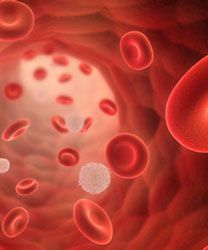SL-401 Granted Priority Review by FDA for BPDCN
A biologics license application for SL-401 (tagraxofusp, Elzonris) has been granted a priority review by the FDA as a treatment for patients with blastic plasmacytoid dendritic cell neoplasm, Stemline Therapeutics, the developer of the novel stemness inhibitor, has announced.
multiple myeloma

A biologics license application (BLA) for SL-401 (tagraxofusp, Elzonris) has been granted a priority review by the FDA as a treatment for patients with blastic plasmacytoid dendritic cell neoplasm (BPDCN), Stemline Therapeutics, the developer of the novel stemness inhibitor, has announced.
SL-401 is being investigated as a first-line or later treatment in patients with BPDCN in a phase I/II trial (NCT02113982). The agent is directed at the IL-3 receptor, which is overexpressed on cancer stem cells and/or tumor bulk in many hematologic malignancies.1
Positive findings from the phase I/II trial were presented at the 2017 ASH Annual Meeting, where SL-401 demonstrated strong activity in patients with BPDCN.2Across 3 stages of the trial, 42 patients received SL-401 at a dose of 12 μg/kg each day. In first-line BPDCN, the overall response rate (ORR) was 90% (26 out of 29 evaluable patients), with a complete response (CR) rate of 72% (21 of 29).
After therapy with SL-401, 45% of patients (13 of 29) were bridged to stem cell transplant (SCT). In patients with relapsed/refractory BPDCN, the ORR was 69% (9 of 13), with a 38% CR rate (5 of 13), and 1 patient was bridged to SCT.
The median overall survival was not reached in patients who received SL-401 therapy in the first-line setting. In the pivotal stage 3 cohort, the study met its primary endpoint with a 54% CR rate (7 of 13). The ORR was 77% and 46% of patients were bridged to SCT (6 of 13). The most common treatment-related adverse events (AEs) were alanine aminotransferase increase (52%), aspartate aminotransferase increase (50%), hypoalbuminemia (50%), and thrombocytopenia (38%). Capillary leak syndrome was also noted in 19% of patients, which was grade 5 in 1 patient.
Under the Prescription Drug User Fee Act, the FDA is scheduled to make a decision on the BLA by February 21, 2019.
“The acceptance of our BLA for filing and grant of priority review represent tremendous milestones for Stemline and the BPDCN patient community. We would like to thank the patients and their families who participated in our clinical trials, as well as recognize the tireless work of our investigators and entire Stemline team. Given both priority and breakthrough status, our commercial organization is positioning itself to rapidly launch Elzonris, if approved, to ensure this important new treatment reaches patients as quickly as possible,” Ivan Bergstein, MD, Stemline’s CEO, said in a statement.
The most significant adverse event (AE) associated with SL-401 is the risk of capillary leak syndrome. During the phase I/II study, all patients are being closely monitored for signs of capillary leak. Other AEs associated with the drug are mostly grade 1/2 in severity, and include hypoalbuminemia, increases in aspartate and alanine aminotransferase, and thrombocytopenia.1
BPDCN affects mostly elderly patients, who may not be able to tolerate chemotherapies. SL-401 may have a better safety and toxicity profile for this patient population due to its targeted mechanism of action. The drug is an IL-3 conjugated truncated diphtheria toxin, which essentially delivers diphtheria toxin to cells that have the IL-3 receptor. Many hematologic malignancies have CD123 expression, but BPDCN in particular has characteristically high expression. When the diphtheria toxin penetrates a cell, it binds to and ADP-ribosylates elongation factor 2, a factor necessary for protein translation. When the protein synthesis process is inhibited, the cell dies by apoptosis.
References:
- Pemmaraju N, Sweet KL, Lane AA, et al. Ongoing phase 2 clinical trial of SL-401 in patients with blastic plasmacytoid dendritic cell neoplasm (BPDCN): stage 1 and stage 2 results. Poster presented at: the 59th American Society of Hematology Annual Meeting; December 9-12, 2017; Atlanta, GA. http://www.stemline.com/ScientifcPresDownloads/SL-401/BPDCN%20Pivotal%20Results%20ASH%202017.pdf. Accessed April 9, 2018.
- Stemline Therapeutics presents detailed SL-401 pivotal data in BPDCN at ASH and kicks off its BPDCN awareness campaign; updated results from ongoing trials in additional malignancies also presented [press release]. New York, NY: Stemline Therapeutics, Inc; December 13, 2017. http://ir.stemline.com/news-releases/news-release-details/stemline-therapeutics-presents-detailed-sl-401-pivotal-data. Accessed April 4, 2018.
Telehealth Continues to Show Importance Post COVID-19 in Rare Diseases
December 29th 2024In an interview with Peers & Perspectives in Oncology, Doris M. Ponce, MD, MS, a bone marrow transplant specialist, discussed how telehealth made a significant impact on patients with rare diseases receiving medical care and why the rules from the COVID-19 era should be brought back to continue helping these patients.
Read More
Brunner Discusses Dosing Approaches for ESA and Novel Therapies for Low-Risk MDS
December 23rd 2024During a Case-Based Roundtable® event, Andrew M. Brunner, MD, discussed dosing strategy for erythropoiesis-stimulating agents as well as dose modifications and safety for the novel agents imetelstat and luspatercept.
Read More
Epcoritamab Delivers Durable Responses in Anthracycline-Ineligible LBCL
December 12th 2024Fixed-duration, subcutaneous epcoritamab-bysp achieved durable responses with a manageable safety profile in older patients with newly diagnosed large B-cell lymphoma who are not candidates for anthracycline-based therapy.
Read More